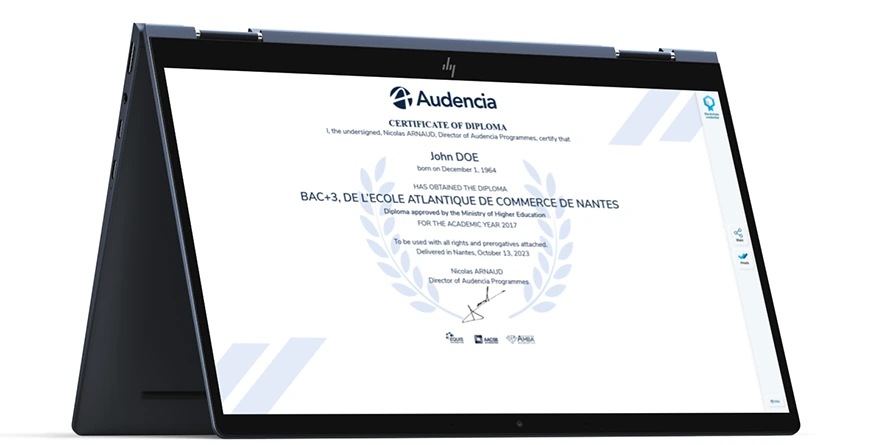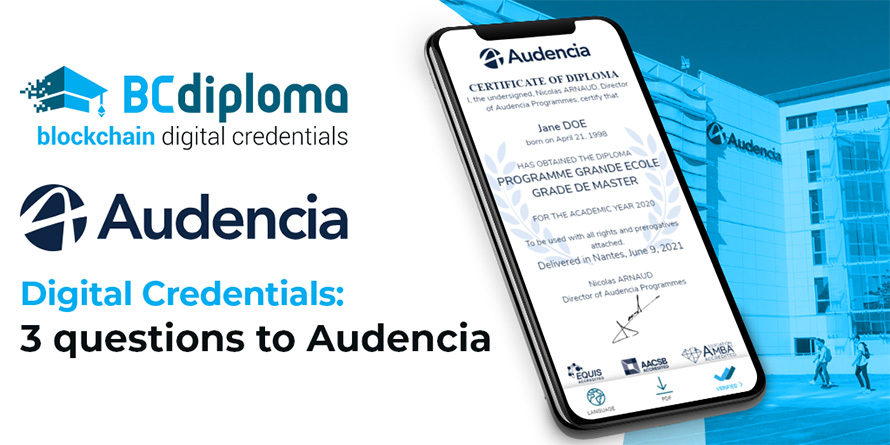Audencia is committed to expanding the services it offers to its graduates, and has decided to provide them with a permanent, tamper-proof micro certified online diploma, called Digital Micro Credential. Fond of new technologies, it has chosen blockchain technology to secure data and ensure a framework of trust for the different players using the system.
Audencia’s official address on the Ethereum public blockchain and compatible EVM blockchains is 0x6e1fb760839Cc50Ec92Dd1de47D835ab4455939D.
This address is tamper-proof and registered in the blockchain registry of institutions authorized to issue data on the BCdiploma platform. This registry can be accessed directly by following this link.
All graduates of the Bachelor, Sciencescom and Grande Ecole programs in the last 10 years have been given a secured URL that they can publish on their resumes and professional social networks. People interested in their profile can instantly check the authenticity of their diploma with a simple click, thus eliminating any doubts about it. The following classes will of course benefit from the same service.

The layout may vary depending on the screen size on which the micro credential example is displayed, but the information will always be the same. At the top right, you can change the language of the certificate (French or English). Below, a link allows to generate a printable version with a QR code; this QR code, when flashed, opens a browser and points directly to the blockchain URL of the digital certificates or badges. Finally, at the very bottom, the link to the various proofs of the Digital Credentials examples.
3 questions to Jean Guillemot, CIO of Audencia, in charge of the “diploma credential in the blockchain” project
Is blockchain in line with Audencia’s responsible commitments?
The blockchain, like any digital activity, consumes energy. We chose the Ethereum ecosystem precisely because it offers a set of blockchains that are much less energy-intensive than the Bitcoin blockchain. In addition, without going into technical details, Ethereum is expected to migrate soon to Ethereum 2, a “Proof Of Stake” model much more ecofriendly than the “Proof Of Work” model and which we will be, with BCdiploma, among the first users. Finally, we should compare the carbon footprint of a classic model where graduates can request a certificate several times during their life, which will have to be verified, printed and sent by mail, to a model where the credential is generated only once on the blockchain and can be viewed for life.
Are blockchain Digital Credentials GDPR compliant?
The BCdiploma system is fully compliant. As this is personal information, the graduates keep control of it. Specifically, they may request to have their certificates revoked so that they are no longer accessible. But I doubt we get many of these requests…
How do blockchain Digital Credentials differ from the graduate directory?
Many companies and recruitment agencies have well-established processes in which it is necessary to provide a document so that it can be inserted into an EDM (Electronic Document Management). A confirmation on an online directory is not convenient for them. And if we added a PDF file generator to our directory, it would be easy for anyone, with very limited means, to use it to generate fake certificates. Instead, writing the Digital Credential data on the blockchain makes it tamper-proof and allows the evidence to be displayed easily. The blockchain plays the role of a digital notary, a digital mortgage registrar or an online cadastral service. A falsifier can always try to alter an Audencia diploma, but viewing the evidence on the blockchain will immediately uncover the fraud.
